Saturday, January 03, 2004
Fouree antoninianus, Valerian, ?, Göbl 885d type
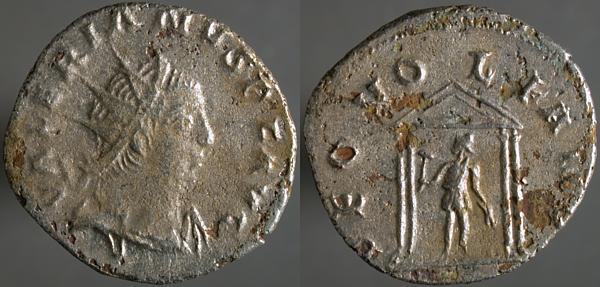
VALERIANVS P F AVG, Radiate draped cuirassed bust right / DEO VOLKANO, Tetrastyle temple with statue of Vulcan within, holding hammer left and tongs? right.
The official issue was minted at Colonia Agrippinensis (today's Köln). There is no way, of course, of knowing where the counterfeit was made. Warren Esty indicates that many late-second and third century imitiations are from the Balkans.
Like Thursday's entry, this is an ancient counterfeit and a fouree from a time when the official coins were still of billon, a badly debased silver, but not yet of silvered bronze. I don't yet have an official model of this coin, but I do have an example of Göbl 884d, which differs only by the addition of an anvil at Vulcan's feet. The counterfeiter here did a better job on the reverse than on the obverse.
Friday, January 02, 2004
Æ25, Nicomedia in Bithynia, Gallienus, unpublished w this legend?
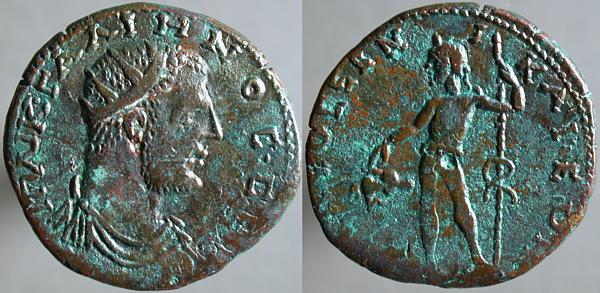
Γ Π ΛΙΚ ΓΑΛΙΗΝΟC CΕΒ, Radiate draped cuirassed bust right / [...]VΟ CΕΒ Ν_Ι_ΚΑΙΕUΝ, Dionysus standing left, holding thyrsus right, pouring from kantharos left.
Some notes on Nicomedia here, here, and here.
Not the most beautiful portrait, but a fairly graceful Dionysus, and a nice blue color in the patina. It was, if I remember, the first apparently unpublished coin I obtained.
Thursday, January 01, 2004
Fouree antoninianus, Salonina, ?, mule of Göbl 889 type
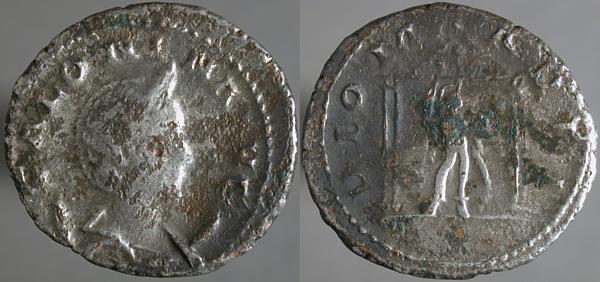
SALONINA AVG, Draped diademed bust right on crescent / DEO MARTI, Tetrastyle temple with statue of Mars within, holding spear left, leaning on shield right.
An ancient counterfeit, note that the figure of Mars is reversed from the official issues, which only exist for Gallienus. The surface of this coin, visibly degraded, is a thin layer of silver applied to bronze. Some time after the official model of this coin was produced, other techniques were used to achieve a similar effect on official issues.
Wednesday, December 31, 2003
Æ24, Pautalia in Thrace, Faustina II, Sear Greek Imperial 1726
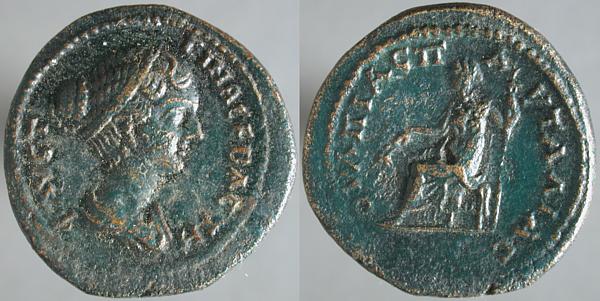
ΦΑVCΤ_ΤΙΝΑ CΕΒΑCΤΗ, Diademed draped bust right / ΟVΛΠΙΑC Π_Α_VΤΑΛΙΑC, Demeter seated left holding ears of grain left and a scepter right.
Faustina II, Pautalia in Thrace. Another example, which looks quite different in detail.
The conventional advice to the new collector is to specialize, but it's rare that a new collector would know what interests them enough for a specialty. Collections tend to accumulate some nice pieces that don't fit. I quite like this, but it certainly doesn't fit.
Tuesday, December 30, 2003
Æ25, Nicaea in Bithynia, Valerian, SNG von Aulock 7068
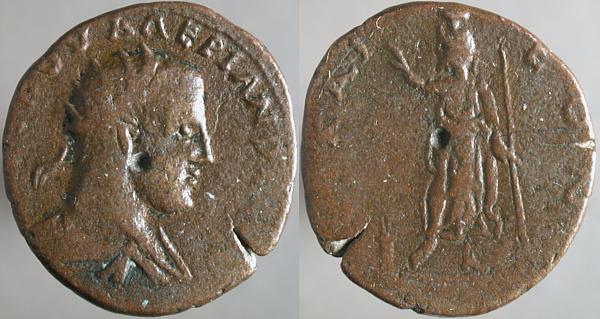
[ΠΟV ΛΙ]Κ ΟVΑΛΕΡΙΑΝΟ[C CΕ], Radiate draped cuirassed bust right / ΝΙΚΑΙ_ΕΩΝ, Serapis standing facing, head left, holding scepter right, raising hand left. Altar at feet left.
Even though Serapis is an Egyptian god, he shows up rather far afield, as on this Bithynian coin. Travel within the empire may have been strenuous and sometimes risky, but people did travel, for business and pleasure, and their cults travelled with them.
Monday, December 29, 2003
Billon antoninianus, Gallienus, Mediolanum, Göbl 1000r
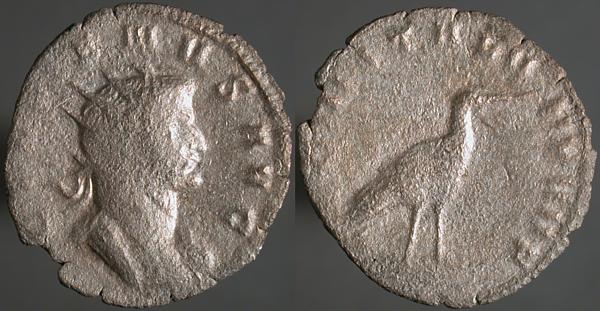
GALLIENVS AVG, Radiate cuirassed bust right / LEG III ITAL VII P VII F, Stork standing right.
Not the best preserved coin, this has the almost melted look common to low-quality silver that's been buried in acidic European soil for well over a millenium-and-a-half.
The legionary series, minted at Milan, was issued with reverse legends ending in V P V F, VI P VI F, and VII P VII F, honoring the legions for dutifulness and faithfulness for the 5th, 6th, and 7th times, respectively. (Dutifulness and faithfulness by the legions being their contribution to victory, it seems.) The VI coins (issued to honor the legions that fought against Ingenuus) are by far the commonest, and this was sold as such. Careful inspection, though, shows that it is VII, issued to honor the legions that fought against Regalianus.
Sunday, December 28, 2003
Æ25, Nicaea in Bithynia, Valerian, unknown
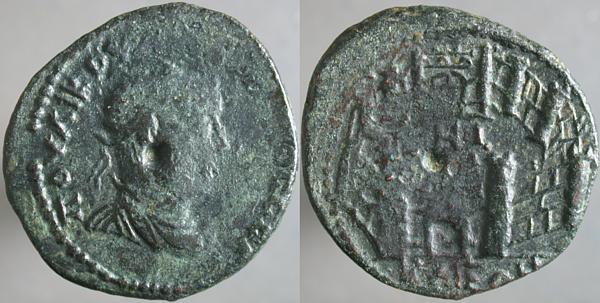
ΠΟV ΛΙΚ ΟV[...]ΟC CΕΒ, Laureate draped bust right / ΝΙ / ΚΑΙΕΩΝ, City walls of Nicaea, with two gates.
Nicaea used this reverse for a number emperors in the middle of the third century, but I haven't seen it cataloged for Valerian. Despite a low grade and prevailing disinterest in coins of this era, it required a high bid on ebay, because everybody loves camp gates and city gates only make it worse.

